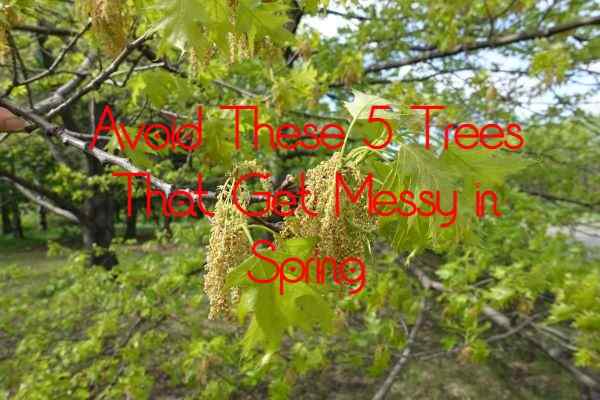Choosing the right tree for your yard can be a big decision. You want to make sure you have a tree that grows well in the soil and sun conditions of your yard, one that is easy for you to maintain, and likely, one that does not get messy. Messy trees are those that drop large amounts of anything—leaves, seeds, fruits, acorns, nuts, or pods. Trees are also considered messy if they drop things that are especially hard to clean up from the ground.
Planting trees that become messy trees in the spring will add to the list of spring-cleaning chores you already need to do around your house and your property. You can make your life easier and save time by choosing trees that aren’t messy trees in the spring. To help you out, here are five trees that get messy that you may want to avoid planting on your property.
1. Northern Red Oak
Northern red oak trees bring double the mess because they drop both big leaves and acorns. If the acorns fall from a tall enough height, they can even potentially cause damage to any car windows or other glass. Most people think this mess just happens during the autumn season, but these are also messy trees in the spring because they drop large flower clusters, called catkins, everywhere. This happens especially during the months of April and May.
These trees also grow at a pretty fast rate, at more than 2 feet each year for the first 10 years. At maturity, they are 60 to 75 feet tall and approximately 45 feet wide.
2. Cottonwood Trees
Cottonwood trees are extremely large, spreading trees that do have a certain majestic feel to them at maturity. But during the late spring into the early summer, these trees release cottony seeds. They sound harmless, but they will completely cover your lawn, like a layer of downy cotton snow, and they get caught everywhere, such as in the window screens of your home. In addition to this, cottonwood trees drop a lot of sticks and leaves.
Read Also: 10 Tips to Help Organize Your Life
Cottonwood trees are the fastest-growing trees in North America. But this quickness results in the trees having weak wood, making them susceptible to diseases—even more of a reason why you may not want it in your yard.
3. Bradford Pear
You may think that Bradford pear trees are a great choice for yards due to their ornamental shape, and a lot of them together do look pretty, but these trees were bred to quickly grow. This may sound like a good thing, but unfortunately, its rapid growth means weak wood. By having weak branches, it is dangerous in storms. As the saying goes, “April showers bring May flowers,” but Bradford pear trees will cause a lot of mess during any spring storm with hard rain and/or wind.
Additionally, the weakness results in these trees only living about 15 years, as they tend to become eyesores and dangerous after that. They’ve also become known as something of an invasive species, giving homeowners another reason to avoid these trees.
Its ornamental shape is a pyramid and can reach heights of 50 feet tall and 35 feet wide.
4. Northern Catalpa
The northern catalpa tree is a pretty common tree that is sometimes classified as a weed. A lot of homeowners don’t intentionally grow this in their yards but end up with it and want to quickly get rid of it due to the big mess it makes. The leaves are heart-shaped and do look beautiful during the spring and summer months, but they only look good on the branches—not covering the ground of your yard when they fall because of heavy breezes or after periods of drought. They are even messier when you try to clean them up because the tree sheds bark, twigs, flowers, and seed pods.
During the months of May and June, northern catalpa trees grow clusters of big, trumpet-shaped white flowers that are fragrant. This adds to necessary cleanup, as flower petals fall everywhere. Plus, the fruit and flowers from the trees are slippery once they fall off.
5. White Mulberry
White mulberry trees come in different sizes and shapes. They even have differently shaped leaves on the same tree. During the spring, the leaves are bright green, and they turn yellow during the fall months before they fall off. They’re messy during the spring because tiny black berries grow on these trees. The black berries are enjoyed by birds, but they fall too, due to birds or heavy storms, making a huge mess and staining the ground.
The male species of these trees also have a lot of pollen, making it difficult if you or anyone in your family suffers from allergies. The seedlings from these trees pop up everywhere.
The common species of white mulberry trees can grow about 30 to 40 feet tall and wide.
If you’re looking to add trees to your yard but don’t want to deal with the problems that can come from messy trees, the above five trees are a few you’ll want to avoid. And many are not only messy trees in the spring but in other months too.
If you’re unsure about which trees you should or shouldn’t plant in your yard, or if you want help in the maintenance of messy trees already planted in your yard, Mr. Tree can help. Contact us today and let us know what you need assistance with. Our trained arborists are experienced in all kinds of trees and know how to help care for messy trees and can help you prevent accidentally planting a tree that will leave you with a mess.




